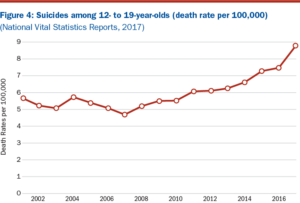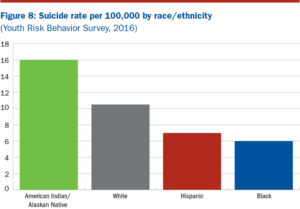Addressing a Crisis: Cross-Sector Strategies to Prevent Adolescent Substance Use and Suicide
A Pain in the Nation Series Report
Adolescent suicide rates are up 87 percent over the last decade with LGBT and American Indian/Alaska Native teens at the highest risk. Some forms of substance use, including vaping, are also on the rise.
Executive Summary
Read the full report
October 29, 2019
Suicide rates among 12 – 19-year olds have increased by a staggering 87 percent between 2007 and 2017 (the most recent available data) making suicide the second leading cause of death among adolescents. In 2017, 7.4 percent of high school students nationwide attempted suicide, a 17 percent increase from the previous year. Nationwide, nearly 3,000 teens died by suicide in 2017.
The use of e-cigarette by teenagers is also skyrocketing. In just one year, 2017, e-cigarette use by high schoolers increased by 78 percent and the number of middle school students using e-cigarettes went up by 48 percent. More teens are also reporting vaping marijuana.

Of additional concern are the large disparities in substance misuse rates and suicide based on a teens’ race, ethnicity, socioeconomic status, sexual orientation/gender status or where they live. Forty-eight percent of gay, lesbian and bisexual adolescents reported considering or attempting suicide as compared with 13 percent of their heterosexual peers. These high rates of suicide risk for sexual minority teens are likely due to stressors they experience including discrimination, bullying, and for some violence and family rejection.
American Indian/Alaska Native teens experience the highest rates of suicide among any race or ethnicity in the United States: 16 suicides per 100,000 deaths among 15 to 19-year olds. The high rates of substance misuse and suicide among American Indian/Alaska Native teens are likely associated with the historical and intergenerational trauma experienced by their community and what is often a lack of education and economic opportunities available to them.

There is some good news. Rates of illicit or interjection and prescription drug use by teens have declined or held steady since 2002. But, despite these trends, 5,455 young people between the age of 15 and 24 died due to a drug overdose in 2017.
Alcohol use among adolescents has also declined. Past month alcohol use among 12 – 17-year olds declined from 18 percent in 2002 to 10 percent in 2017. Lifetime alcohol use among high school students decreased from 82 percent in 1991 to 60 percent in 2017.
Adolescence is a Critical Time to Intervene in Young People's Lives
Adolescence is an important intervention point in teens’ lives. Among adults ages 18-30 participating in substance use treatment programs, 74 percent began using substances before age 17 and half of all lifetime cases of mental illness begin by age 14.
Adolescence is a time of intense change for most teens. Many experience social isolation, depression or anxiety while others are victims of bullying and discrimination. But, adolescence is also a time of opportunity – opportunity to put teens on healthy pathways through programs that strengthen families, provide mentors and foster connectedness especially in schools.
“Adolescence is a challenging time when the impact of poverty, discrimination, bullying and isolation can be intense. Fortunately, there are policies and programs that can reduce some of these circumstances and the risks associated with them by strengthening teens’ coping and emotional-skills – skills that can improve their health and led to their succeeding in schools.”
John Auerbach, President and CEO
Trust for America’s Health
Policies and programs that reduce the circumstances in teens’ lives that put them at risk for unhealthy behaviors, combined with programs that foster connectedness and teach coping and emotional skills, are key to ensuring that teenagers grow into thriving adults. All youth-serving organizations and sectors should work together to embrace strategies that reduce risk factors in teens’ lives and build protective factors.
Examples of risk factors in teens’ lives include poverty, racism and discrimination due to the stressors they create in teens’ lives and for their families. Protective factors are circumstances that increase teens’ coping skills and resilience, including feeling connected to their school community, having a close relationship with family or having a mentor.
Schools play a particularly critical role in teens’ well-being. Research shows that feeling connected to their school community and believing that their teachers and other school staff care about them helps teens stay on positive pathways and reduces their substance misuse and suicide risk.
Teens interact with their community across the spectrum of sectors, including schools, the healthcare system and in some case the juvenile welfare or justice systems. For that reason, coordinated, multisector approaches to support teens will be most effective.
Recommendations for Policy Action
To reverse the troubling rates of teen substance misuse and suicide communities across the country should adopt a prevention framework that harnesses and aligns the strengths of many sectors to create a collective approach to both reducing risk and promoting protective factors in teens’ lives. Furthermore, policies and programs that support families, such as the earned income tax credit, paid-time-off, affordable housing or access to healthcare, will paid divided ends for those families’ children.
Among the report’s top recommendations are:
- The federal government and state legislatures should create and/or scale up policies that support families including increases to federal and state earned income tax credits and programs that provide access to health insurance and affordable housing.
- Congress should increase funding for substance misuse and suicide prevention including Project AWARE and the Garrett Lee Smith State/Tribal Youth Suicide Prevention and Early Intervention Grant program.
- States should expand Medicaid services in schools using flexible models such as school-employed providers, school-based health centers and telehealth.
- Congress should increase investments in the Centers for Disease Control and Prevention’s Division of Adolescent and School Health which promotes safe and supportive learning environments in schools nationwide. Mental health services should be available in all schools.
- Public and private funders should incentivize strategies that address common risk/protective factors across all adolescent serving sectors.
- All youth-serving systems should adopt trauma-informed and culturally appropriate policies and practices and should engage youth leaders in program development.
Read the full report

